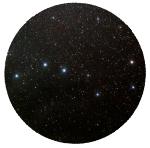Dominating the northern sky is the constellation Ursa Major.
 The asterism Big Dipper or Plough is formed by seven of the stars in Ursa Major or the Great Bear.
The asterism Big Dipper or Plough is formed by seven of the stars in Ursa Major or the Great Bear.
A neighbouring constellation called Bootes has its name derived from the Sumarian Riv-but-sane, which means the "man who drove the cart". So Bootes was identified with a farmer who plows the land during spring. The Romans called Bootes the Herdsman of the Septentriones, that is, of the seven oxen represented by the seven stars of the Big Dipper, which was seen as the cart or the plow.
Big Dipper never touches the horizon in northern europe.
This is why the northern part of the world was called the septentrionale region.



